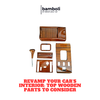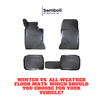Cross Bars vs. Roof Rails - Finding the Perfect Fit for Your Vehicle

Cross bars and roof rails are essential components for carrying extra cargo on your vehicle, but it can be confusing to determine which one is the best option for your specific needs. Understanding the differences between cross bars and roof rails can help you make an informed decision when it comes to outfitting your vehicle for adventure.
Main Points
- Cross Bars: These are typically more versatile and can accommodate various types of attachments, such as cargo boxes, bike racks, and ski racks.
- Roof Rails: These are fixed to the roof of the vehicle and provide a sturdy base for mounting cross bars or other accessories.
- Consider the weight capacity, installation process, and compatibility with your vehicle when choosing between cross bars and roof rails.
- Both cross bars and roof rails can enhance the functionality of your vehicle and make it easier to transport bulky items during an outdoor adventure or road trip.
Understanding the Functionality of Cross Bars and Roof Rails
The Functionality of Cross Bars and Roof Rails:
- Support: The cross bars and roof rails provide support for various types of cargo, such as bikes, skis, luggage, and more. They create a stable platform for securing items on the roof of the vehicle.
- Versatility: These components allow for easy attachment of different types of carriers, like roof boxes, kayak racks, and cargo baskets. This versatility enables you to customize your vehicle for various hauling needs.
- Aerodynamics: Properly installed cross bars and roof rails can improve the aerodynamics of your vehicle by reducing wind resistance. This can lead to better fuel efficiency, especially during highway driving.
Overall, understanding the functionality of cross bars and roof rails is essential for maximizing the utility of your vehicle. Whether you're embarking on a road trip, heading to the mountains for a ski weekend, or simply need extra storage space, these components can make your journey smoother and more efficient.
Factors to Consider When Choosing Between Cross Bars and Roof Rails
When deciding between cross bars and roof rails for your vehicle, there are several factors to take into consideration. Both options have their own advantages and disadvantages, so it’s important to weigh them carefully before making a decision. Below are some key factors to consider:
- Vehicle Type:
One of the main factors to consider is the type of vehicle you have. Cross bars are more versatile and can be used on a wider range of vehicles, while roof rails are typically designed for specific makes and models. Make sure to check the compatibility of each option with your vehicle before making a decision.
- Weight Capacity:
Another important factor to consider is the weight capacity of the cross bars or roof rails. Make sure to check the manufacturer’s specifications to ensure that they can support the weight of your cargo. Overloading can be dangerous and may cause damage to your vehicle.
- Installation:
Consider how easy it is to install and remove the cross bars or roof rails. Some options require drilling or permanent installation, while others can be easily attached using clamps or mounts. Think about how often you will need to use them and choose a convenient option.
|
Factors to Consider |
Cross Bars |
Roof Rails |
|
Vehicle Compatibility |
Wide range of vehicles |
Specific makes and models |
|
Weight Capacity |
Check manufacturer’s specifications |
Check manufacturer’s specifications |
|
Installation |
Easy to attach with clamps |
May require drilling for permanent installation |
By considering these factors, you can make an informed decision between cross bars and roof rails for your vehicle. Take your time to research and choose the option that best suits your needs and preferences.
Benefits of Using Cross Bars for Your Vehicle
Traveling or transporting goods with your vehicle, using cross bars can provide numerous benefits. These handy accessories are designed to fit on the roof of your car, allowing you to easily secure and transport items such as bicycles, kayaks, luggage, and more. Below are some of the key advantages of using cross bars for your vehicle:
- Versatility
One of the main benefits of using cross bars is their versatility. You can easily switch out different attachments depending on what you need to transport. Whether you're going on a camping trip and need to secure a kayak or simply want to transport a bike, cross bars can accommodate a variety of items.
- Increased Storage Space
By using cross bars, you can free up valuable space inside your vehicle for passengers or additional luggage. Instead of cramming everything into the backseat or trunk, you can securely attach items to the roof of your car using cross bars. This can make your journey more comfortable and allow for a smoother ride.
- Better Aerodynamics
When you attach items to the roof of your vehicle without cross bars, it can create wind resistance and impact your fuel efficiency. Cross bars are designed to streamline the airflow over your car, reducing drag and improving aerodynamics. This can help you save money on gas and make your vehicle more fuel-efficient.
Using cross bars for your vehicle can offer a range of benefits, from increased storage space to better aerodynamics. By investing in these versatile accessories, you can make your travels more convenient and efficient. So, consider adding cross bars to your car to enhance your overall driving experience.
Advantages of Opting for Roof Rails for Convenient Transportation
Transporting luggage, bicycles, kayaks, or any other bulky items, roof rails can be a game-changer. Installing roof rails on your vehicle can provide you with numerous advantages that make your journey much more convenient and stress-free.
- Increased Storage Capacity
By opting for roof rails, you can significantly increase the storage capacity of your vehicle. Instead of cramming all your belongings inside the car, you can easily secure them on the roof. This not only frees up valuable space inside the vehicle but also allows for a more comfortable ride for all passengers.
- Versatility in Transporting Items
Roof rails provide a versatile way to transport a wide range of items. Whether you need to carry skis for a winter getaway, bikes for a cycling adventure, or camping gear for a weekend trip, roof rails allow you to securely attach these items to your vehicle's roof. This versatility ensures that you are always prepared for any outdoor excursion.
- Improved Aerodynamics
Contrary to popular belief, roof rails can actually improve the aerodynamics of your vehicle when equipped with a roof box or cargo carrier. By reducing wind resistance, roof rails can help enhance fuel efficiency and reduce noise levels while driving at high speeds. This not only saves you money on fuel but also provides a smoother and quieter ride.
- Easy Installation and Removal
Roof rails are designed to be easily installed and removed, allowing you to adapt your vehicle to your specific needs. Whether you only need roof rails for occasional use or want to keep them permanently attached, the convenience of installation and removal makes them a practical addition to any vehicle.
- Enhanced Exterior Appearance
In addition to their practical benefits, roof rails can also enhance the exterior appearance of your vehicle. With a sleek and modern design, roof rails add a touch of style to your car while also providing functionality. Whether you choose a black or chrome finish, roof rails can give your vehicle a more rugged and adventurous look.
Overall, opting for roof rails can greatly improve your overall driving experience by providing increased storage capacity, versatility in transporting items, improved aerodynamics, easy installation and removal, and enhanced exterior appearance. Consider investing in roof rails for your vehicle to enjoy a more convenient and stress-free transportation experience.
Installation Guide: How to Properly Fit Cross Bars on Your Vehicle
Transporting bulky items such as luggage, bicycles, or kayaks, having cross bars installed on your vehicle is essential. Cross bars provide a stable platform for securing your cargo and help ensure safe transportation. If you want to learn how to properly fit cross bars on your vehicle, follow the step-by-step guide below.
Step 1: Choose the Right Cross Bars
Before you begin the installation process, make sure you have the correct cross bars for your vehicle. Cross bars come in different sizes and styles, so it's important to choose ones that are compatible with your car's make and model. Additionally, make sure the cross bars have a weight capacity that can support your cargo.
Step 2: Position the Cross Bars
Place the cross bars on the roof of your vehicle in the desired position. Make sure they are evenly spaced and aligned parallel to each other. Check the manufacturer's instructions for specific placement guidelines for your cross bars.
Step 3: Secure the Cross Bars
Once the cross bars are positioned correctly, secure them to the roof of your vehicle according to the manufacturer's instructions. Use the provided hardware to tighten the cross bars in place, making sure they are firmly attached and stable. Double-check the installation to ensure the cross bars are securely fastened.
By following these simple steps, you can properly fit cross bars on your vehicle and enjoy a safe and secure way to transport your cargo. Remember, safety is always the most important factor when installing cross bars, so be sure to double-check your work and seek professional help if needed.
Roof Rails Maintenance Tips for Longevity and Performance
Roof rails are an essential component of your vehicle, providing a secure attachment point for roof racks, cargo carriers, and other accessories. To ensure their longevity and performance, proper maintenance is crucial. Here are some tips to help you take care of your roof rails:
- Regular Cleaning
One of the simplest yet most effective ways to maintain your roof rails is by regularly cleaning them. Use a mild soap or car shampoo and a soft cloth to remove dirt, dust, and grime. This not only keeps your roof rails looking good but also prevents corrosion and rust.
- Inspection
Periodically inspect your roof rails for any signs of damage, such as scratches, dents, or loose fittings. Addressing these issues promptly can prevent further damage and ensure the safety and stability of your roof racks and cargo carriers.
- Lubrication
Applying a lubricant to the moving parts of your roof rails, such as the sliding mechanism or locking mechanism, can help prevent wear and tear over time. Be sure to use a lubricant that is compatible with your roof rails to avoid any damage.
Remember: Proper maintenance of your roof rails is essential for their longevity and performance.
|
Tip |
Description |
|
Cleaning |
Regularly clean your roof rails with a mild soap to prevent corrosion. |
|
Inspection |
Check for any damage such as scratches or loose fittings. |
|
Lubrication |
Apply a compatible lubricant to moving parts for smooth operation. |
Enhancing Your Vehicle's Aesthetic Appeal with Cross Bars and Roof Rails
When it comes to customizing your vehicle, there are countless options available to help you achieve the look you desire. One popular accessory that can greatly enhance your vehicle's aesthetic appeal is the addition of cross bars and roof rails. These sleek and stylish additions not only add a touch of sportiness to your vehicle, but they also offer practical benefits as well.
Benefits of Cross Bars and Roof Rails:
- Increased Cargo Capacity: By installing cross bars and roof rails on your vehicle, you can easily attach roof racks, cargo boxes, or bike racks, allowing you to transport bulky items such as luggage, bikes, or outdoor gear.
- Improved Style: Cross bars and roof rails give your vehicle a more rugged and adventurous look, while also adding a touch of sophistication. Whether you're cruising around town or heading out on a road trip, these accessories are sure to turn heads.
- Enhanced Versatility: With cross bars and roof rails, you have the flexibility to customize your vehicle based on your specific needs. Whether you need to transport skis for a weekend getaway or kayaks for a day on the water, these accessories make it easy to adapt your vehicle to any adventure.
Overall, adding cross bars and roof rails to your vehicle is a simple and cost-effective way to enhance both its appearance and functionality. So why not take your vehicle to the next level and invest in these stylish accessories today?
Frequently Asked Questions
What are the main differences between cross bars and roof rails?
Cross bars are separate components attached across the roof of a vehicle, while roof rails are installed parallel to the length of the vehicle's roof.
Can cross bars and roof rails be used interchangeably?
In most cases, cross bars and roof rails are not interchangeable due to differences in installation and design.
Do cross bars and roof rails have weight limitations?
Yes, both cross bars and roof rails have weight limitations that should not be exceeded for safety reasons.
Are cross bars and roof rails compatible with all vehicles?
Not all vehicles are compatible with cross bars or roof rails, so it's important to check for compatibility before purchasing.
Can cross bars and roof rails be installed at home?
Installation of cross bars and roof rails can vary in difficulty, but many can be installed at home with the right tools and instructions.
-
Posted in
Accessories, Advantages, Installation, Interior, Roof rack, roof rail, simple to use, Ski racks, sports racks




